Extension Gardener: Crystal Coast
go.ncsu.edu/readext?412747
en Español / em Português
El inglés es el idioma de control de esta página. En la medida en que haya algún conflicto entre la traducción al inglés y la traducción, el inglés prevalece.
Al hacer clic en el enlace de traducción se activa un servicio de traducción gratuito para convertir la página al español. Al igual que con cualquier traducción por Internet, la conversión no es sensible al contexto y puede que no traduzca el texto en su significado original. NC State Extension no garantiza la exactitud del texto traducido. Por favor, tenga en cuenta que algunas aplicaciones y/o servicios pueden no funcionar como se espera cuando se traducen.
Português
Inglês é o idioma de controle desta página. Na medida que haja algum conflito entre o texto original em Inglês e a tradução, o Inglês prevalece.
Ao clicar no link de tradução, um serviço gratuito de tradução será ativado para converter a página para o Português. Como em qualquer tradução pela internet, a conversão não é sensivel ao contexto e pode não ocorrer a tradução para o significado orginal. O serviço de Extensão da Carolina do Norte (NC State Extension) não garante a exatidão do texto traduzido. Por favor, observe que algumas funções ou serviços podem não funcionar como esperado após a tradução.
English
English is the controlling language of this page. To the extent there is any conflict between the English text and the translation, English controls.
Clicking on the translation link activates a free translation service to convert the page to Spanish. As with any Internet translation, the conversion is not context-sensitive and may not translate the text to its original meaning. NC State Extension does not guarantee the accuracy of the translated text. Please note that some applications and/or services may not function as expected when translated.
Collapse ▲
Extension Master Gardener Volunteers working together at Beaufort Historic Association site
Welcome to Extension Gardener: Crystal Coast
Our Goals
- Provide you, the gardener, with reliable, research-based information on all things gardening.
- Add new content each week throughout the year in the form of articles, videos or other media.
We hope you will visit often to see what new information we have available.
If you have questions, we hope you will take a moment to click on the Ask an Expert button on the left of the page and ask your question. Our trained volunteers will be happy to provide you an answer.
Below is a short welcome video to give you an explanation of what we hope to provide for you.
What’s New this week
The Beautiful Coneflower
by Judy F. Farmer
My goal with 3 garden beds is to increase butterfly, bee, and hummingbird plants in an informal setting. I made a good start with Rudbeckia. I want to overplant to reduce space for any PENNYWORT, my antithesis!
Rudbeckia maxima, Cabbage Coneflower
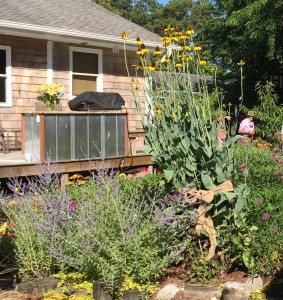
Cabbage Coneflower plant is over 6 feet tall.
I planted three roots in full sun and watered them frequently the first 2 weeks. The cabbage leaves came out quickly and the plant grew and grew. I learned that this coneflower was salt and heat tolerant, loves the sun and sandy soil, and overwinters well. It is now 6’6” tall and 3’9” broad. After researching, I found that propagation is through seed and dividing the existing plant.
I think the plant is so widely spread because the roots have reached the water table! What fun I have watching it grow! I hope to split it this Fall. I have saved 3 cones for propagation, but plan to leave the rest for the birds. A neighbor has already taken a free cutting. Sharing spreads happiness!
For 2 years I didn’t know the plant’s common or Latin name. After taking the Master Gardeners’ class, I am more informed about how to research plant information. Below, I have provided links for plants discussed in this article.
Rudbeckia hirta, Black Eyed Susan
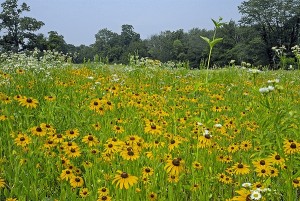
Black-eyed-Susan in a meadow with other flowers.
I planted this coneflower, Rudbeckia hirta, Black-eyed Susan, from seed, mixed with potting soil, and then covered the planting area with leaves. This Rubekia loves full sun and does well in our sandy soil. I allowed the original plants to fully reseed. The result after 2 years is a wonderful grouping that reflects sunshine and lifts my spirits daily.
Rudbeckia laciniata, Cutleaf Coneflower
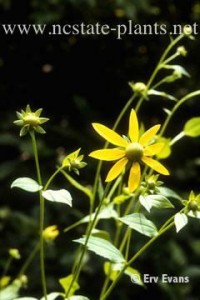
Cutleaf Coneflower by Erv Evans
I just planted a Rudbeckia laciniata, Cutleaf Coneflower in full sun, but so far have no flowers. The pointed flower has 10 droopy, yellow petals, with a greenish yellow cone. The challenge will be to provide the plant with enough water, so I’ll watch it closely.
Wish List
Rudbeckia fulgida, Orange Coneflower
The first cone flower on my wish list is Rudbeckia fulgida, Orange Coneflower. This coneflower will grow in zone 8, but has orange flowers; I hate orange.
Rudbeckia subtomentosa, Sweet Coneflower
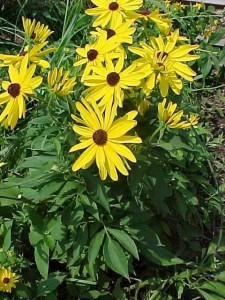
Bold flowers of Rudbeckia subtomentosa.
The second coneflower on my wish list is Rudbeckia subtomentosa, Sweet Coneflower. This plant likes moist areas and can grow in zone 8, but is not drought tolerant. I’m in pursuit of seed or plant.
Rudbeckia triloba, Brown-Eyed Susan
The third wish list item is Rudbeckia triloba, Brown-Eyed Susan, which likes colder climates, so I am not sure it will grow here. Butterflies like its nectar and songbirds, especially American Goldfinches, love it’s seed, so I am in pursuit of finding seed or plant.
If you are interested in more colorful cultivars, consult on-line seed catalogs, using the identifiers “coneflowers” or “Rudbeckia.” “Echinacea” will also pull up daisy looking cultivars. Happy searching!
Links for this article:
For images of the many cultivars of Rudbekia.
Troubles with Tomatoes
By Shawn Banks
It’s that time of the year again when the tomato woes begin.
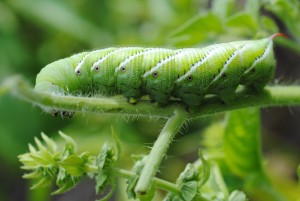
Tomato Hornworm
Insect pests including the dreaded tomato/tobacco hornworm, stink bugs, aphids and fruit worms will start making their appearance on the plants. Keep an eye open for any insects as you go through the garden every day or two and and pick any insect pest you find. What you do with them after you get them off the plant is up to you. I prefer to feed the worms to birds and wasps by putting them in the middle of the driveway. Stink bugs usually get the bricks method of control; you know smash them between two bricks, that way I know they won’t be coming back. Aphids I will usually leave for the beneficial insects unless the populations are getting out of control and then I squish them with my fingers, but you may want to use an insecticidal soap or another insecticide listed for use on tomatoes.
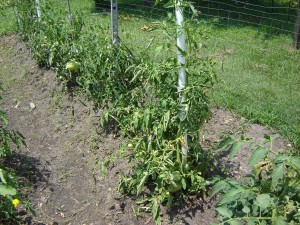
One wilted plant in a row
Often it’s a disease that is most damaging to tomato plants. With the heat and humidity, it is very important to have good spacing (at least 2 to 3 feet) between plants to make sure there is ample air circulation to dry off the leaves and fruit. This is a big help in preventing fungal pathogens from taking hold and infecting the fruit or the plant. Another cultural practice that often helps is applying a mulch of some type (newspaper, shredded leaves, straw, wood chips or something else) around the base of the tomato plants. Many of the pathogens survive in the soil over the winter and splash up onto the lower leaves where they make their initial infection before moving up the plant through splashing water. The mulch also helps keep the moisture in the soil a little longer on these hot summer days. If you catch the infection early, often simply removing the infected leaf will prevent the spread. Sometimes a fungicide is needed. Before spraying, the disease should be identified to make sure you apply the best product for the job.
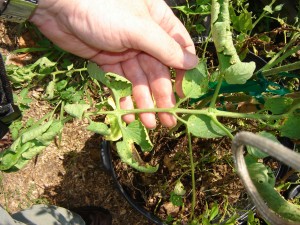
Spots on the leaf of a wilting plant
Many people complain about the entire plant wilting. When this happens the first thing to consider is soil moisture. If the soil is too wet or too dry that may be what is causing the plant to wilt. In the case of the soil being too dry, add some water and see if that helps. If the soil moisture seems to be fine, then look at the leaves. Are the leaves turning yellow? If so what is the pattern of the yellow, is it at the tips of the leaves, only the bottom leaves, maybe only the top leaves that are turning yellow or maybe there are leaf spots? If no color is observed on the leaves and the soil moisture is fine, it may be that bacterial wilt is the issue. Sacrificing one plant for the good of the garden may be the only way to find out what the problem is. In the case of fungal wilts such as Verticillium and Fusarium cutting away a section of the stem to see if the color under the bark is white, green, brown, reddish-brown or gray is a good way to determine the most likely problem. White or green associate with wilting it is likely a soil moisture or viral wilt. Brown or Reddish-brown and there is likely a fungal wilt at play. Gray and the problem is likely bacterial in nature.
If you are having issues with your tomato plants and would like to have help in diagnosing the problem, you can either drop a sample off at the extension office (3rd floor of the CMAST building, 303 College Circle) or send some pictures of the problem. We will need a picture of the entire plant to give us an idea of the extent of the problem, a close up of the leaf top and bottom as well as a picture of the fruit if that is where the problem is. Please call ahead to make sure staff is available to assist you should you need to come to the building.
As always, before applying any pesticide, always read and follow the label directions. It will help keep you and the environment safe.
Happy Gardening!




